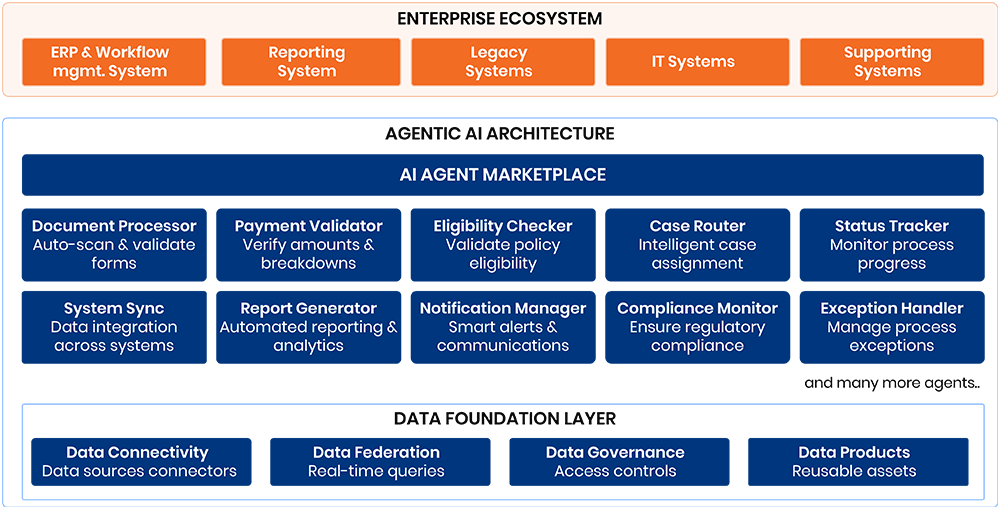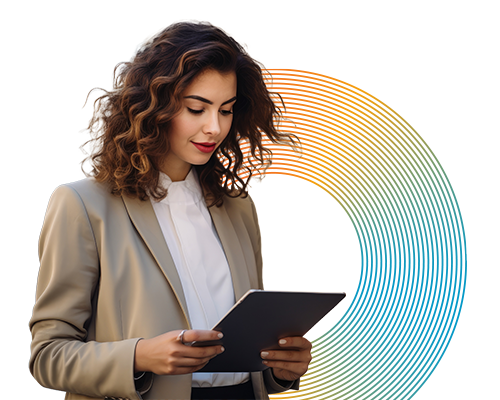Rewiring the Enterprise with Agentic AI: Succeeding Intelligently

AUTHOR
Ghazal Mehndiratta, Sr. Manager, Platform Marketing
The Enterprise stack isn’t just broken—It’s obsolete and will slow your business down
Over the last two decades, enterprise architecture has grown increasingly complex, yet oddly stagnant. At the bottom: data lakes, warehouses, spreadsheets. In the middle: apps, platforms, dashboards. On top: processes and people stitching it all together. This hierarchy was built for a slower, more deterministic world—where insight could wait, decisions followed meetings, and monthly reporting cycles sufficed.
That world is gone.
Today, businesses are drowning in data but starved for intelligence. They're expected to respond in real time to shifting customer expectations, market turbulence, and operational disruptions. Static dashboards, brittle workflows, and manually triggered processes can no longer keep up.
What’s emerging in its place is not just a smarter toolset, but a fundamentally different layer: an intelligence layer. And at the heart of that layer is Agentic AI.

Figure 1: Traditional enterprise stack vs. the emerging intelligence layer. From dashboards to decisions—this new layer drives real-time action and coordination.
From Automation to Agency: What Makes This Different
Let’s be clear, automation is not new. Enterprises have used macros, scripts, bots, and triggers for years. Even RPA promised to ‘automate everything’. But these approaches relied on rigid, pre-coded instructions.
Agentic AI is different.
Agentic AI refers to autonomous software entities ("agents") that don’t just follow instructions—they understand goals, observe systems, reason over data, plan actions, and adapt based on outcomes. They’re not static scripts—they’re dynamic problem-solvers that proactively figure out what to do next.
What’s revolutionary isn’t that they save time. It’s that they change the very structure of work.
The Urgency Behind the Shift and What the Intelligence Layer Actually Does
But understanding what makes Agentic AI different is only part of the story. What’s fuelling its urgency today is a set of converging forces reshaping enterprise demands.
Legacy enterprise systems weren’t built for today’s speed, scale, or complexity. Workflows that once functioned well in slower, siloed environments now struggle under modern demands. Meanwhile, AI infrastructure has matured—LLMs and multimodal models now support real-time reasoning, planning, and decision execution.
Agentic AI responds to this moment—not by adding more automation, but by becoming the connective intelligence of the enterprise. These intelligent agents integrate across systems, interpret goals, and coordinate execution. They retain shared context, adapt continuously, and operate at enterprise scale.
The result: a pervasive intelligence layer—distributed, integrated, and always learning—that enables the enterprise to act, not just analyze.
This new level of capability requires not just smarter tools—but smarter design. Let’s explore how to build it —starting with the architecture that powers intelligent agents at their core.
Architecting the Intelligence Layer: Design with Intent
Agentic AI demands an intentional, systems-level approach. It’s not simply about adding another tool—it’s about embedding intelligence deeply and cohesively into your enterprise architecture.
This begins with defining how agents operate: how they perceive data, interpret goals, execute plans, and adapt based on outcomes—all while adhering to enterprise-grade standards for security, compliance, and governance.
But architecture alone isn't enough. Organizations must provision the right supporting infrastructure—compute environments, orchestration frameworks, observability tools, and governance mechanisms. These behind-the-scenes components are critical to scale reliably and avoid costly fragility.
To function effectively, this layer must:
Interface with heterogeneous systems
Retain context across workflows
Support dynamic planning and execution
Be observable, governable, and fault-tolerant by design
To bring these capabilities to life, organizations often deploy agents using containerized microservices—coordinated through event-driven platforms like AWS Step Functions or Temporal. Agents may be hosted in serverless environments (e.g., AWS Fargate) or Kubernetes clusters (e.g., EKS), depending on workload complexity and scalability needs.
These components form the basis of modular agents that can operate independently or in collaboration with others.
Without this architectural foundation, Agentic AI risks becoming another brittle automation layer—rather than the connective intelligence it's meant to be.
Now, let’s explore what makes this level of integration possible.
Integration Patterns: Make Intelligence Native to Your Stack
Agentic systems thrive when integrated as first-class citizens in your architecture—not bolted on. Key patterns include:
Event-driven architectures: Use services like Amazon EventBridge or Kafka to trigger agents based on real-time signals—changes in data, user actions, or system events.
Abstraction layers: Introduce GraphQL APIs, Amazon API Gateway, or middleware to shield agents from legacy system complexity.
Context Memory: Persist shared state and long-term memory using Amazon Neptune (graph DB), DynamoDB, or vector stores for embedding-based recall
Best Practice: Deploy agents as containerized services on AWS Fargate or EKS, orchestrated with step functions or temporal workflows for resilience, scale, and modularity.
Managing the Realities: Integration Challenges You Can’t Ignore
Building an intelligence layer introduces new design considerations—but with the right foundations, these are entirely manageable.
Enterprise-ready Agentic AI requires thoughtful integration across data, systems, and controls. Anticipating these dimensions early ensures agents behave reliably, securely, and in alignment with enterprise objectives.
Here’s what to expect—and how to stay ahead:
| Challenge | How to Address It |
|---|---|
| System Incompatibility | Use middleware adapters or API gateways to enable seamless interaction with legacy and third-party systems. |
| Data Inconsistency | Establish schema standards and build automated validation pipelines to ensure agents operate on clean, reliable inputs. |
| Agent Drift | Use feedback loops, regular goal alignment checks, and bounded autonomy policies to prevent agents from veering off-course. |
| Decision Transparency | Require agents to log their reasoning and actions and embed human-in-the-loop checkpoints for critical decisions. |
| Compliance Gaps | Integrate agents into audit frameworks, enforce role-based access (RBAC), and use secure APIs with traceability. |
When engineered intentionally, the intelligence layer doesn’t introduce fragility—it builds resilience, transparency, and control into enterprise decision-making.
With foundational architecture and integration in place, the next frontier is scale—where plug-and-play intelligence becomes possible. Let’s see how this plays out in the next section.
Agent Marketplaces: A New Frontier for Enterprise Intelligence
Just as app stores democratized software access, agent marketplaces are emerging as the next big unlock. These marketplaces offer a growing catalog of intelligent, task-specific agents—each designed to handle discrete workflows with autonomy, accuracy, and adaptability.
Instead of building AI capabilities from scratch, enterprises are now tapping into pre-built, plug-and-play agents> that integrate directly with existing systems and data layers. Whether it’s a Document Processorthat auto-scans forms, a Payment Validator that verifies transactional breakdowns, or a Case Router that intelligently assigns workloads, these purpose-built agents dramatically reduce development effort while accelerating time to value.
At the centre of this model lies the Agentic AI Architecture—a layered design that makes intelligence native to the enterprise. It spans three interconnected tiers:
Enterprise Ecosystem: The operational surface where value is delivered—ERP systems, legacy platforms, IT tools, and supporting systems.
AI Agent Marketplace: A modular layer of multiple intelligent agents, each built to solve specific tasks, yet designed to collaborate fluidly across workflows.
Data Foundation Layer: The backbone of the architecture, providing connectivity, federated access, governance controls, and reusable data products—ensuring every agent operates with context, compliance, and confidence.

Figure 2: Agent Marketplace Architecture Illustration
Together, these layers form a unified intelligence fabric —where agents don’t just plug into systems, they understand them. And when designed to work in harmony, they don’t just act—they collaborate.
Designing for Synergy: Where Coordination Becomes Intelligence
Deploying agents is just the beginning. The true power of Agentic AI unfolds when these agents operate as an intelligent network—sharing context, building on each other’s outputs, and driving coordinated outcomes that that go far beyond what individual automation can deliver.
Consider this example:
Email Agent detects pricing updates from incoming correspondence and passes relevant data to downstream agents.
Reconciliation Agent uses this input to validate information against internal systems, enriching the context.
Insight Agent informed by both prior agents, summarizes discrepancies and notifies the right stakeholders—completing the workflow without human orchestration.

Figure 3: How multiple agents collaborate in real-time to drive action
This synergy isn’t just automation—it’s a living, evolving system of collaboration across digital specialists.
Even in highly regulated industries, this pattern holds. A Fortune 100 financial services firm transformed a 17-step premium processing workflow by deploying AI agents across document validation, payment verification, compliance monitoring, and intelligent case routing. This resulted in a 60% reduction in processing time, 80% fewer manual errors, and nearly 40% lower operational overhead—proving that agent coordination drives real operational outcomes.
With the intelligence layer in place, enterprises are not just transforming operations—they’re laying the groundwork for a new era of human-agent collaboration.
Why This Isn’t Hype—It’s a Strategic Shift
Agentic AI represents a fundamental redesign of enterprise operations—not just a technical evolution, but a new way of working. It’s not an add-on; it’s a rethink of how decisions are made, and work gets done.
According to IDC, by 2026, over 55% of enterprise workflows will involve autonomous agents embedded directly into operations. Gartner adds that organizations adopting agentic architectures have already seen a 35% improvement in decision cycle times within the first year—signalling not just future potential, but current impact. This shift is already underway. Enterprises that act now will gain exponential efficiency and decision advantage.
Transforming Enterprise Data: Meet Avrio, the AI-Powered Platform Revolutionizing Data-to-AI Journeys
While intelligent agents drive action, the foundation of any intelligence layer is the data they rely on. That’s where Avrio comes in - , Trianz's groundbreaking solution that's changing the game for how businesses interact with their data.
Avrio generates real-time analytics, insights, opportunities, risks, and recommendations from all your data through intuitive conversations or a series of prompts. Think of it as having a data scientist who speaks your language – literally. This AI-powered, no-code data platform unifies your entire Data-to-AI journey making complex data analytics as simple as having a conversation.
Key Features That Set Avrio Apart
Universal Data Connectivity: Seamlessly connects to 50+ data sources—on-premises, cloud, and SaaS breaking down those frustrating data silos that have plagued organizations for years.
Enterprise Data Marketplace: Build data products within minutes and publish them in an enterprise data marketplace that users can consume from.
Zero-Migration Gen BI/Analytics: Enables real-time analytics and insights without costly migrations or complex ETL pipelines . Your data stays where it is but becomes infinitely more accessible. Gen BI is available natively within Avrio and also connects with tools such as Quicksight, Tableau or Power BI.
Unified views and Analytics from Structured AND Unstructured Data: Avrio’s AI can generate and combine analytics from structured and unstructured data such as emails, chats, PDF files etc. to generate holistic insights.
Conversational Intelligence: Users can interact with their data in plain English through conversational AI, democratizing data access across teams and skill levels.
Agentic Marketplaces: Leverage a ready-to-use marketplace of AI agents—each designed to autonomously perform tasks like reconciliation, enrichment, and decision-making—tailored to user behaviour and business needs.
Built-in Governance: Built-in governance, zero-move data federation, and self-service data products ensure your data remains secure and compliant while being accessible.
The Real-World Impact
Avrio's data productization approach revolutionizes how you access and utilize data, creating what feels like an Amazon Prime Video* or Netflix*-style experience for enterprise data. Imagine a well-organized marketplace where all your enterprise and third-party data is readily available as data products, accessible to authorized users in a simple, intuitive experience.
The results speak for themselves: Avrio's unified interface replaces fragmented toolchains, reduces costs, ensuring compliance, and maintains data quality, while enabling teams to transform raw data into actionable insights in weeks rather than months.
But Avrio is more than just a data platform—it’s the intelligence-ready foundation that powers Agentic AI. By unifying data access and context, it enables intelligent agents to not only analyze data, but to plan, reason, and act in real time.
For organizations ready to move beyond traditional data analytics and embrace the future of intelligent data platforms, Avrio marks a –fundamental shift toward truly democratized, AI-powered data experiences.
Bring Intelligence to the Center of Your Enterprise
The intelligence layer is no longer optional—it’s foundational. Agentic AI is already driving tangible results in enterprises across industries, from faster reconciliations to reduced manual work.
Want to see how this works in practice?
Book a live demo of AVRIO to explore how Agentic AI can reshape your operations—without replacing your existing systems.
*Netflix trademark is owned by Netflix®, Inc. and Trianz and its services are not affiliated with nor endorsed by Netflix®, Inc.
*Prime trademark is owned by Prime video®, Inc. and Trianz and its services are not affiliated with nor endorsed by Prime video®, Inc.
Request a Demo TODAY!
Take the leap from data to AI
